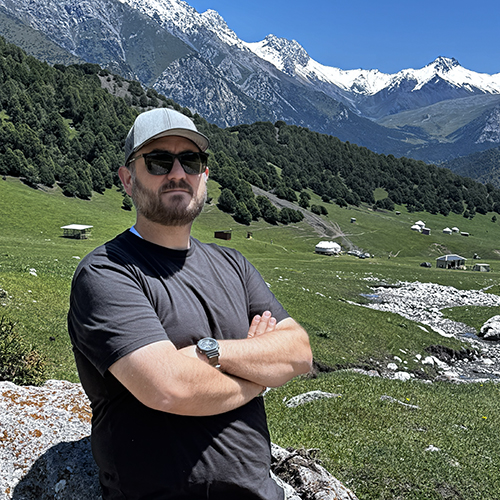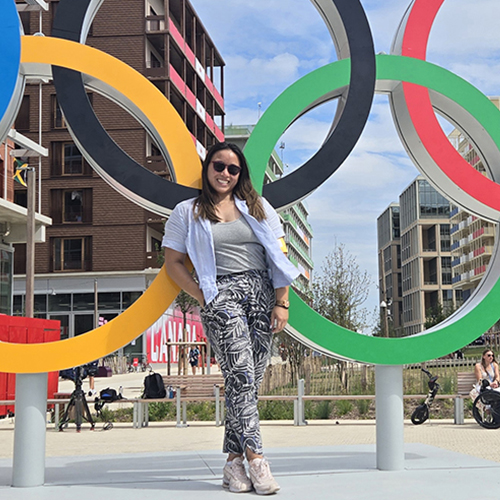Think small. Even smaller. Smaller still. Eventually you’ll get to the nanoscale, where a revolution in technology is taking place. At the UW’s Center for Nanotechnology, scientists from many disciplines are working at this scale to learn more about basic science and to create new and previously unimaginable technologies.
“Nanotechnology evolved from manipulation and measurement of matter at unprecedented resolution,” says Charles Campbell, professor of chemistry, who recently replaced Viola Vogel as director of the Center. “It’s meant a quantum leap in what we could do.”

A nanometer, one billionth of a meter, is about 10,000 times narrower than a human hair. At that size, says Campbell, all sorts of things become possible. There is potential, for example, to make a structure and place it inside a cell to attack disease organisms without disturbing the cell. “Can you imagine little devices that can non-invasively navigate cell biology?” he muses.
Scientists working at the nanoscale are also developing tiny switches, shuttles, and materials that react to their environment on the molecular level, which could lead to such innovations as buildings and bridges that “heal” themselves, self-repairing clothing, and powerful computers the size of a button. And nanoscience allows unprecedented opportunities to explore basic research questions in biology, physics, chemistry, and other fields. With more than 55 UW scientists involved with the Center, research is taking off in all these areas—and many more.
“There’s strong interplay between all of these projects,” says Campbell. “Each of us takes advantage of what others have done. We’ve gone well beyond critical mass at the UW and have a lot of synergy among players.”
Pretty impressive, given that the Center for Nanotechnology was established just seven years ago through the UW’s University Initiatives Fund (UIF). The
idea for the Center grew out of weekly meetings held by 20 faculty across campus who were working on the nanoscale.
“We talked about what we were doing,” recalls Campbell, “and from that we developed a vision for what we might be able to do with colleagues that would take our research to the next higher level.”
With UIF support, the Center built a user facility in Fluke Hall with specialized equipment to probe, analyze, and manipulate samples at the nanoscale. The equipment is available for use by faculty and students across campus, with staff providing the necessary training and support. The facility, run by Dr. Dong Qin, is also available to other academic institutions, researchers, and industrial users for a fee, and recently won a prestigious role in the National Nanotech Infrastructure Network.
Nine UW departments form the Center, including two—chemistry and physics—from the College of Arts and Sciences. It offers the nation’s first Ph.D. program in nanotechnology, to be combined with a concurrent degree in science, engineering, or medicine.
A central component of the Center is its weekly seminar series, which provides a forum for bringing national and international leaders in the field to the University of Washington. “It is one of the best attended seminars on campus,” says Campbell. The seminar series is so popular, in fact, that graduate students have now supplemented it with their own nanoseminar to discuss their Ph.D. research.
Many of the students’ presentations are likely to include a mention of Pacific Northwest National Laboratory (PNNL), a Department of Energy laboratory with close ties to the Center. The two institutions offer a Joint Institute in Nanoscience, an annual two-day nanoscience workshop, and opportunities for UW students to pursue research at PNNL’s well-equipped facility in Richland, Washington.
“We have a great relationship with PNNL,” says Campbell. Having worked at a national laboratory when he was a student, Campbell encourages his students to do the same. “I want our graduate students to take advantage of this opportunity to learn from our PNNL colleagues,” he says. It helps that PNNL provides $800,000 annually to support UW student research, both on campus and at its facility. (Other sources of student support include the University of Washington Initiatives Fund and the National Science Foundation Integrative Graduate Education and Research Traineeship.)
Recently PNNL teamed up with the UW and Washington State University for a new offering: intensive courses in nanotechnology held at PNNL’s Richland facility. “The PNNL scientists like to interact with students and teach,” says Campbell, “so they’re teaching these courses practically for free. It’s mostly hands-on training on really sophisticated equipment, but there are also lectures. It gives us a chance to offer some really advanced special topics courses for our graduate students.”

Not that students can’t find plenty of courses on campus. The Center offers three nanotechnology courses, and about 40 nanoscience-related courses are offered in member departments. That number should increase as nanotechnology becomes essential to more areas of research.
“Nanotechnology is going to be to the next half century what microelectronics was to the past half century,” asserts Campbell. He pauses, then adds, “Actually, it will probably be more important.”
More Stories

Through Soil Science, an Adventure in Kyrgyzstan
Chemistry PhD alum Jonathan Cox spent most of 2025 in Kyrgyzstan, helping farmers improve their soil—and their crops—through soil testing.

A Sports Obsession Inspires a Career
Thuc Nhi Nguyen got her start the UW Daily. Now she's a sports reporter for Los Angeles Times, writing about the Lakers and the Olympics.

The Public Impact of Private Cities
Geography major Edwin Bai has researched private cities, developed by individuals and corporations, that "take the libertarian idea of low government regulation to the maximum."